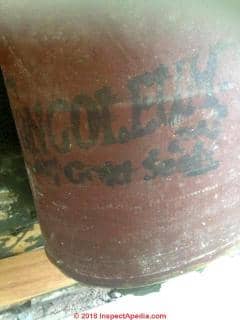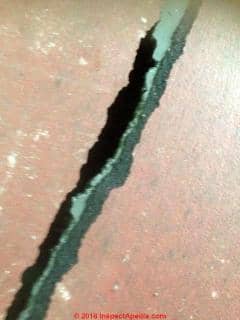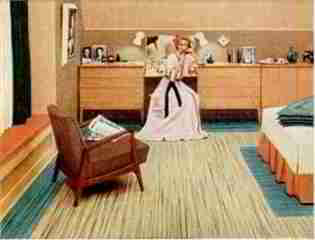 Floor Tiles & Sheet Flooring Components & History FAQs
Floor Tiles & Sheet Flooring Components & History FAQs
Q&A on the history & constituents of floor coverings & asbestos
- POST a QUESTION or COMMENT about the history & asbestos or other contents of floor tiles.
Questions and answers about the history and ingredients of and in resilient floor tiles & asbestos-containing flooring.
Asphalt Floor Tiles, Asphalt-Asbestos Flooring, Vinyl-Asbestos Flooring, Linoleum, Ceramic & Cork floors, Painted Floor Canvas, Floor Tiles.
This article sereis describes the history of resilient floor tiles and sheet flooring, including the production and ingredients in asphalt-based floor tiles and vinyl-asbestos floor tiles. We list companies producing floor coverings along with historic dates and types of products manufactured.
InspectAPedia tolerates no conflicts of interest. We have no relationship with advertisers, products, or services discussed at this website.
Q&A on History of Asphalt Floor Tiles & Vinyl-Asbestos Floor Tiles
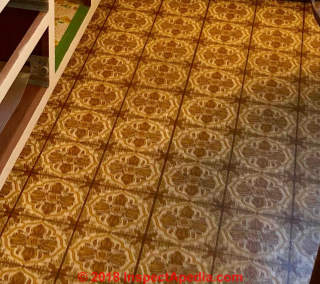 These questions & answers about flooring & floor tile history and ingredients were posted originally at FLOOR TILE HISTORY & INGREDIENTS; be sure to review that article.
These questions & answers about flooring & floor tile history and ingredients were posted originally at FLOOR TILE HISTORY & INGREDIENTS; be sure to review that article.
At the end of this article you will find a list of guides to identify different types of floor coverings, sheet flooring, linoleum, Armstrong flooring, Congoleum rugs, sheet flooring, tiles, and other floor tiles that may contain asbestos.
On 2019-01-31 by Adrienne
@Amy, Did you ever figure out if it did? We have the same in our kitchen
On 2018-10-23 by (mod) - Asbestos in 1970's Armstrong no-wax flooring
For a definitive answer you will need to have a lab test performed on a flooring sample.
On 2018-10-23 by Amy
Does anyone know if the following Armstrong no wax vinyl flooring definitively contains asbestos? It was installed in between the mid 70's to early 80's. Thank you
On 2018-09-02 1 by (mod) -
Jennifer
Use the page top or bottom CONTACT link to send me a private email if you will accept our financial help in paying the asbestos test lab fee.
See also ASBESTOS TESTING LAB LIST
On 2018-09-02 by Jennifer McKenna
Thank you so much for all your help. I love my old house and would love to enjoy this interesting find. I'm going do some research and see if I can find a lab near me that tests for asbestos. Wish me luck.
On 2018-09-02 by (mod) -
Kudos for the Canadian Congoleum Rug photos. How fabulous to actually have a date stamp of June 1, 1928.
I will sharpen these up and add them to CONGOLEUM-NAIRN FLOORING
for the benefit of other readers and to invite comment.
In that article we discuss which Congoleum products (Congoleum Nairn) have been confirmed to have contained asbestos, and we state
Asbestos was found in at least these Congoleum flooring products: Congoleum-Nairn Flor-Ever Vinyl, Fashionflor Cushioned Vinyl flooring, Gold Seal Vinyl Inlaid flooring, Gold Seal Vinyl Nairon Standard flooring.
FYI looking at a later Congoleum rug catalog from the 1940's (linked-to in the article I gave above) the word "asbestos" does not appear.
I think that at least some older Congoleum rugs contain no asbestos.
If you decide you want your Congoleum tested for asbestos let me know and I'll arrange to cover that cost.
On 2018-09-01 by Jennifer McKenna - Asbestos in Congoleum sheet flooring in an older Canadian home on Cape Breton
I hope you received all the pics. Let me know what you think. Thanks so much for your help.
Hi again. good to know the pic went through alright and its nice to see you've been over my way. Cape Breton is beautiful.
On 2018-09-01 by (mod) -
Jennifer
When you add an image (you can add one per comment but you can comment as many times as you wish) I receive a notification - but the moderator has to approve the photo before it will appear on the page.
I am sorry for the confusion and the delay. That approval step is necessary to prevent posting of inappropriate content or malware.
You can also send us photos attached to email by using the page top or bottom CONTACT link.
Thanks.
Daniel
PS the photo below is me on my first bike trip to Cape Breton in 1974
On 2018-09-01 by Jennifer McKenna
Hi again. Im not great on computers thus the two questions lol. I keep trying to send you pics but they just wont work and i have no idea how to make them work.
My house is at least 110 years old and its located in nova scotia canada. the flooring was actually made at congoleum canada limited in montreal. if you can send me some advise on how to get the pics to work i would love to send you all the pics i have
On 2018-08-31 by (mod) - While true linoleum does not contain asbestos some versions of Congoleum might.
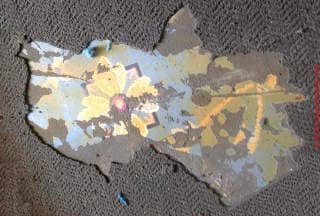 Jennifer
Jennifer
While true linoleum does not contain asbestos some versions of Congoleum might.
Please see details at CONGOLEUM-NAIRN FLOORING
There you'll see that some rug patterns of sheet flooring used an asphalt-felt backer that may contain asbestos.
I would be grateful to see a couple of sharp photos of your old flooring and to know the country and city of its location as well as the house age.
On 2018-08-31 by Jennifer McKenna
Hi im renovating a room in my house and found old linoleum. It is a 1928 gold seal congoleum art rug. pattern 326 and Im wondering will this contain asbestos?
On 2017-03-14 by (mod) -
Susan,
You can use our page top or bottom CONTACT link to send photos for comment.
Please see our list of flooring ID guides where you'll see ARMSRTRONG flooring keys by ranges of years. If you can guess when the floor was installed that'll be helpful.
Sorry I don't recognize L4 19097 2245 ARMSTRONG but I suspect that's a newer floor tile. Unless Armstrong can answer thequestion themselves, we pretty much have to look at the pattern AND the age.
On 2017-03-14 0 by Susan
I'm wondering if the floor tiles in my kitchen contain asbestos. They are made by Armstrong and have L4 19097 2245 Armstrong on the back. I will email a couple of photos to post.
On 2017-01-27 by (mod) -
Lida:
Quite likely. See https://inspectapedia.com/hazmat/Armstrong_Tile_List_1970-72.php
On 2017-01-27 by Lida
Does Armstrong vinyl tile called Stylistic Plaza woodtile 28005 installed in 1979contain asbestos
On 2016-03-16 by (mod) -
Flax
I'm not sure what sort of heating wire you intend to install so I'd not install it before reviewing the manufacturer's installation specifications. Or give them a call directly.
On 2016-03-16 by Flaxen
My house was built in 1990. Under some peel and stick tiles in my kitchen is vinyl sheet floor.
But under that appears to be some hard type of flooring (not wood and not concrete). Could this be asbestos?
If so, can I leave it there and put heating wire and ceramic tiles over it?
On 2016-03-08 by (mod) -
Chris
Use the Add Image button below the Comments Box
or
You'll find our email at the page top or bottom CONTACT link. I'll be glad to take a look.
Daniel
On 2016-03-08 by Chris
How do you upload a picture of Laminate flooring I have a question about?
Question: I removed some 6" ceramic tiles that I estimate were from the late 70's or early 80's - would these ceramic tiles contain asbestos?
A few years ago I removed an area of ceramic tiles from the floor of my house. They were about 6inches square and 0.5 inches deep and were ceramic or possibly concrete. I am unsure of there age but estimate late 70s early 80s
Would it have been likely that these tiles contained asbestos or were asbestos containing tiles restricted to the vinyl type? If it makes any difference our location is England. Any information you could give would be gratefully received Thanks - A.H. PS - your website is great and really useful
Reply: asbestos-ceramic tile risks, history in the UK, recommendations
From the age you give, and considering that the ceramic tiles could have been in stock for some time before they were installed, having been thus made in the 1970's, they indeed could have contained asbestos, but we have been unable to find an authoritative source that confirms that asbestos was ever used as a component of ceramic floor tiles or wall tiles.
Watch out: A more likely asbestos hazard one might encounter when removing ceramic floor or wall tiles would be an asbestos-containing tile mastic - the glue that was used to secure ceramic tiles on walls and floors in a thin-set installation methods. You would not expect to find asbestos below ceramic tiles at an older installation at which the tiles were bedded directly into cement - the "thick set" method for tile installation.
The history of asbestos use and regulation in the UK could have permitted your ceramic tiles, installed in the 1980's, to contain asbestos.
A brief-history of asbestos usage and asbestos regulation in the UK
A documented asbestos-related death in the UK occurred as early as 1906. Asbestos regulation began in the UK in 1931, and in 1965 mesothelioma had been documented there. Imports of asbestos into the U. K. peaked in 1967.
By 1970 the UK had banned the import of raw crocidolite and amosite asbestos was banned (voluntary ban) in 1980.
More strict licensing regarding asbestos handling and remediation did not begin in the UK until 1980s.
And the first licensing regulations date from 1983, while in the U. k. asbestos-containing product prohibitions date from 1985 with UK asbestos material regulation amendments in 1988, 1992, 1994 and onwards to a final "comprehensive ban" in 1999. Silverdell, [7]
The actual hazard of their removal would have depended on their condition, how they were removed, and the quantity. Generally the asbestos released from ceramic tiles removed relatively intact should be quite low.
Please take a look at CERAMIC TILE, ASBESTOS / LEAD? , where we discuss ceramic floor tiles that may contain asbestos, the hazards and some recommendations.
At References at the end of this article we cite authoritative sources for that information.
On 2015-04-08 by (mod) - History of Armstrong's exit from European flooring business
Great question, Phil. I've done some preliminary research but nothing authoritative. My impression was that since there were floor tile fabricators in the UK & Europe most US flooring made in the US was sold in North America.
Some of the larger manufacturers such as Armstrong had and have fabrication plants around the world - it's likely that the same designs would have been sold in the UK but fabricated there not in the US (not that that matters in re the formula or contents). But I suspect that there was not complete congruence: that is, a catalog of Armstrong flooring sold in the UK or in Australia & New Zealand may have for reasons of public preference, not included exactly the same pattern set as sold in North America.
Help me out: see if you can find (for example online ) copies of antique floor tile catalogs for the UK - that should answer our question.
Keep me posted or send along details using the email found at our page top or bottom CONTACT link
PS: Armstrong decided to exit the European flooring business just last year, announced in a press release on 11 December 2014:
LANCASTER, Pa., Dec. 11, 2014 /PRNewswire/ -- Armstrong World Industries, Inc. (NYSE: AWI) today announced that, following a review of strategic alternatives, it has decided to exit its European flooring business and cease further funding of its DLW subsidiary effective immediately. As a result of this decision, local DLW management filed for insolvency in Germany.
"Our difficult, but necessary, decision to exit the European flooring business and discontinue funding our DLW subsidiary in Germany was the culmination of a comprehensive evaluation of strategic alternatives following years of disappointing results, multiple restructuring initiatives and significant financial investments," said Armstrong CEO, Matthew J. Espe.
DLW management concluded that its operations could not be financed and sustained without funding from its Armstrong parent and, as a result, filed for insolvency under applicable German law. Armstrong expects all operations at the two DLW manufacturing plants in Germany, as well as at the DLW administrative offices across Europe, to continue in the normal course for the near term. A preliminary insolvency administrator in Germany will be appointed by the local court. As a result of the insolvency filing and Armstrong's loss of control of the DLW operations, Armstrong will classify the results of the European flooring business as discontinued operations starting in the fourth quarter of 2014. The following provides a summary of the operating results of the European flooring business for the nine-month period ended September 30, 2014 (previously shown as part of the Resilient Flooring reporting segment).
Net sales $144.7 million
Operating loss ($23.2) million
In addition, the carrying value of assets was $152.0 million as of September 30, 2014, including property, plant & equipment of $73.4 million and inventory of $57.1 million. The carrying value of liabilities was $171.3 million as of September 30, 2014, including an unfunded pension liability of $126.5 million.
Armstrong acquired DLW in 1998 to establish a stronghold and serve as a catalyst for the development of its European flooring business. DLW subsequently struggled with declining market conditions as a result of the ongoing economic crisis, including a significant decrease in public funding, which particularly affected the business's key commercial segments, notably hospitals and schools.
These developments contributed to intensified price pressure and overcapacities within the whole European flooring industry, further weakening DLW's competitive position. "Despite investing approximately $150 million in the business since 2007, DLW has been unable to generate profit or achieve its strategic plans. These results, and our ultimate decision, however, in no way reflect the dedication, effort and commitment of DLW employees over the years, for which we remain grateful," Mr. Espe continued.
Uncertainties Affecting Forward-Looking Statements
Disclosures in this release, including without limitation, those relating to future financial results guidance, and in our other public documents and comments contain forward-looking statements within the meaning of the Private Securities Litigation Reform Act of 1995. Those statements provide our future expectations or forecasts and can be identified by our use of words such as "anticipate," "estimate," "expect," "project," "intend," "plan," "believe," "outlook," "target," "predict," "may," "will," "would," "could," "should," "seek," and other words or phrases of similar meaning in connection with any discussion of future operating or financial performance.
Forward-looking statements, by their nature, address matters that are uncertain and involve risks because they relate to events and depend on circumstances that may or may not occur in the future. As a result, our actual results may differ materially from our ex
As a result, our actual results may differ materially from our expected results and from those expressed in our forward-looking statements. A more detailed discussion of the risks and uncertainties that could cause our actual results to differ materially from those projected, anticipated or implied is included in the "Risk Factors" and "Management's Discussion and Analysis" sections of our reports on Forms 10-K and 10-Q filed with the U.S.
Securities and Exchange Commission. Forward-looking statements speak only as of the date they are made. We undertake no obligation to update any forward-looking statements beyond what is required under applicable securities law.
About Armstrong
Armstrong World Industries, Inc. is a global leader in the design and manufacture of floors and ceilings. In 2013, Armstrong's consolidated net sales totaled approximately $2.7 billion. As of September 30, 2014, Armstrong operated 34 plants in eight countries and had approximately 8,600 employees worldwide.
SOURCE Armstrong World Industries, Inc.
On 2015-04-08 by Phil Bolton
Hi
Just a general question did most of the companys listed export to europe specificaly the UK this is just purely out of professional interest as i am an Asbestos Surveyor and i like to put a name to products in my reports.I recognise similar products especially in the Matico range of tiles.
Thanks
On 2014-06-06 by Cassandra Cameron
Hello I am trying to replace my vinyl floor in my kitchen and I want to make sure there is no asbestos. The house was constructed in 1983 so it is possible. I don't know what brand my sheet vinyl is but I do have pictures. Can you help?
On 2011-12-26 by (mod) -
Loretta, while asbestos was widely used in flooring produced by many manufacturers in the 1970's I would not make a blanket assumption that all flooring made contained asbestos.
On 2011-12-25 by Loretta
Did all vinyl floor tiles contain asbestos in 1972-1973?
On 2011-11-02 by (mod) - Flooring with burlap backing: may contain lead?
Flooring with burlap backing:
Thanks for that interesting note about lead in flooring backing - that's news to me. I don't have a sample of such material at hand but if you do, or if you find some, send me a sample, it can be as small as one square inch of flooring material, and I'll test for and document the presence of lead on all surfaces of the material.
Use the CONTACT link found on our pages.
On 2011-11-02 by Flooring with burlap backing
FYI: The flooring with burlap backing is usually high in lead content. This is very important due to its age (old) and if children are playing on it.
On 2011-09-27 by (mod) -
I agree completely, James. Wed like to see a photo of the flooring you tested, and to hear a guess at its age. Use the CONTACT link to send us photos if you have 'EM.
On 2011-09-27 by James Anderson edgewater Florida
Ya watch out for sheet flooring the backing i tested was 60% asbestos 40% latex, 1/16 of an inch, looks like grey paper, non friable, use a p100 half mask respirator 15.00 and ventilate, clean before taking off.
...
Continue reading at FLOOR TILE HISTORY & INGREDIENTS - topic home, or select a topic from the closely-related articles below, or see the complete ARTICLE INDEX.
Or see these
Key Asbestos Flooring Articles
- ASBESTOS FLOORING IDENTIFICATION - home
- ASBESTOS FLOORING IDENTIFICATION GUIDE INDEX - all brands, all years
- ASBESTOS FLOOR TILE IDENTIFICATION PHOTOS 1949-1959
- ASBESTOS TILE MANUFACTURE
- ASBESTOS FLOOR TILE PRODUCT NAMES
- ASBESTOS FLOORING HAZARD REDUCTION
- ASBESTOS FLOORING IDENTIFICATION GUIDE INDEX - all brands, all years
- ASBESTOS FLOORING REMOVAL GUIDE
- ASBESTOS MATERIAL REGULATIONS - dates of various asbestos bans & regulations
- ASBESTOS TESTING LAB LIST
- ASBESTOS TESTING SAMPLE COLLECTION
- FLOOR TILE HISTORY & INGREDIENTS
- FLOOR TILE / SHEET FLOORING PHOTO GUIDES - list of photo guides useful to recognize & identify asbestos-containing floor tiles or sheet flooring
- FLOOR TYPES & DEFECTS - home
- RESILIENT SHEET FLOORING ID GUIDE
Suggested citation for this web page
FLOOR TILE HISTORY & INGREDIENTS FAQs at InspectApedia.com - online encyclopedia of building & environmental inspection, testing, diagnosis, repair, & problem prevention advice.
Or see this
INDEX to RELATED ARTICLES: ARTICLE INDEX to ASBESTOS HAZARDS
Or use the SEARCH BOX found below to Ask a Question or Search InspectApedia
Ask a Question or Search InspectApedia
Questions & answers or comments about the history and production of asbestos-containing flooring and floor tiles
Try the search box just below, or if you prefer, post a question or comment in the Comments box below and we will respond promptly.
Search the InspectApedia website
Note: appearance of your Comment below may be delayed: if your comment contains an image, photograph, web link, or text that looks to the software as if it might be a web link, your posting will appear after it has been approved by a moderator. Apologies for the delay.
Only one image can be added per comment but you can post as many comments, and therefore images, as you like.
You will not receive a notification when a response to your question has been posted.
Please bookmark this page to make it easy for you to check back for our response.
Our Comment Box is provided by Countable Web Productions countable.ca
Citations & References
In addition to any citations in the article above, a full list is available on request.
- [1] EPA, U.S. Environmental Protection Agency, Asbestos in Your Home, web search 08/31/2011, original source: www.epa.gov/asbestos/pubs/ashome.html
- [2] EPA Guidance for Controlling Asbestos-Containing Materials in buildings, NIAST, National Institute on Abatement Sciences & Technology, [republishing EPA public documents] 1985 ed., Exposure Evaluation Division, Office of Toxic Substances, Office of Pesticides and Toxic Substances, U.S. Environmental Protection Agency, Washington,D.C. 20460
- [3] EPA: "Asbestos Management", U.S. Environmental Protection Agency, Region 7, original author: Todd H. Dresser, Environmental Engineer, (formerly of), Burlington Board of Health, 29 Center Street, Burlington, MA 01803, web search 3/4/2012 original source: epa.gov/region07/education_resources/teachers/ehsstudy/ehs2.htm, [copy on file as: /hazmat/Asbestos Management _ Region 7 _ US EPA.pdf ]
- [4] US EPA, DECONSTRUCTION - BUILDING DISASSEMBLY AND MATERIAL SALVAGE - THE RIVERDALE CASE STUDY [PDF] U.S. EPA, web search 3/4/12, original source: epa.gov/wastes/conserve/rrr/imr/cdm/pubs/river.pdf, [copy on file as: /hazmat/Deconstruction_Riverdale_EPA.pdf]
- [5] TOXICS INFORMATION SERIES: ASBESTOS [PDF], U.S. EPA, April 1980
- [6] EVER WEAR TILE CO is currently (2009) in the Terrazzo, Tile, Marble, and Mosaic Work industry in Fallon, NV. 775) 423-6221. [We do not know the company history nor whether there is an association with EverWear vinyl asbestos floor tiles discussed in this article.]
- [7] HISTORY OF ASBESTOS IN THE UK - THE STORY SO FAR ..., Silverdell PLC, 14 Buckingham St., London WC2N 6DF TelP 0207 389 6906, email: info@silverdell.plc.uk website: www.silverdell.plc.uk. Web search 3/4/12, original source: issuu.com/silverdell_plc/docs/silverdell_history_of_asbestos_article
- [8] Armstrong ® Residential Flooring - Website 05/15/2010 https://www.armstrongflooring.com/ lists current flooring products provided by the Armstrong Corporation, including Armstrong's current vinyl floor tile products at https://www.armstrongflooring.com/flooring/products/vinyl-floors
- [9] Armstrong Corporation, Corporate History - https://www.armstrongflooring.com/corporate/corporate-history.html - Web Search 05/19/2010
- [10] Armstrong vinyl asbestos floor tiles: photos of asbestos floor tiles as catalog pages (PDF form) are at www.asbestosresource.com/asbestos/tile.html
- [11] Thanks to Armstrong Corporation (800-356-9301) for providing information about the dates of manufacture of peel-and-stick floor tiles, email July 2010
- [12] "Asbestos in your home or at work," Forsyth County Environmental Affairs Department, Winston-Salem NC 12/08
- [22] CERAMIC TILE - WHAT IS ASBESTOS ? [PDF] Resource4Mesothelioma, Mesothelioma Information and Legal Guide web search 3/6/2012, original source: resource4mesothelioma.com/topics/whatisasbestos.html and
also
CERAMIC TILE ASBESTOS [local copy] original source mesothelioma.com/asbestos-exposure/products/ceramic-tiles.htm - [23] ASBESTOS, ITS INDUSTRIAL APPLICATIONS, D.V. Rosato, engineering consultant, Newton, MA, Reinhold Publishing, 1959 Library of Congress Catalog Card No.: 59-12535 [out of print, original copy, text and images provided by InspectAPedia.com (c)].
- [24] Microwave thermal inertisation of asbestos containing waste and its recycling in traditional ceramics.
Leonelli C, Veronesi P, Boccaccini DN, Rivasi MR, Barbieri L, Andreola F, Lancellotti I, Rabitti D, Pellacani GC.
Dipartimento di Ingegneria dei Materiali e dell'Ambiente, Università di Modena e Reggio Emilia, Via Vignolese 905, 41100 Modena, Italy. leonelli@unimore.it Journal of Hazardous Materials 135 (1–3): 149–155 - Citation: J Hazard Mater. 2006 Jul 31;135(1-3):149-55. Epub 2006 Jan 10., web search 3/6/2012, original source: http://www.ncbi.nlm.nih.gov/pubmed/16406335
- [25] ASBESTEOS-CERAMIC, Wikipedia, web search 3/6/2012, original source: http://en.wikipedia.org/wiki/Asbestos-ceramic
- Kentile Floor Company History - see http://fadingad.wordpress.com/2007/08/25/kentile-floor-company-second-ave-ninth-street-brooklyn/ - Web Search 05/19/2010
- Mannington Mills Corporation - see http://www.mannington.com/Corporate/OurCompany/History.aspx
- Books, Complete List of Environmental Inspection, Diagnosis, Cleanup, Air Quality & Design, Inspection, Repair Books at the InspectAPedia Bookstore
- In addition to citations & references found in this article, see the research citations given at the end of the related articles found at our suggested
CONTINUE READING or RECOMMENDED ARTICLES.
- Carson, Dunlop & Associates Ltd., 120 Carlton Street Suite 407, Toronto ON M5A 4K2. Tel: (416) 964-9415 1-800-268-7070 Email: info@carsondunlop.com. Alan Carson is a past president of ASHI, the American Society of Home Inspectors.
Thanks to Alan Carson and Bob Dunlop, for permission for InspectAPedia to use text excerpts from The HOME REFERENCE BOOK - the Encyclopedia of Homes and to use illustrations from The ILLUSTRATED HOME .
Carson Dunlop Associates provides extensive home inspection education and report writing material. In gratitude we provide links to tsome Carson Dunlop Associates products and services.


